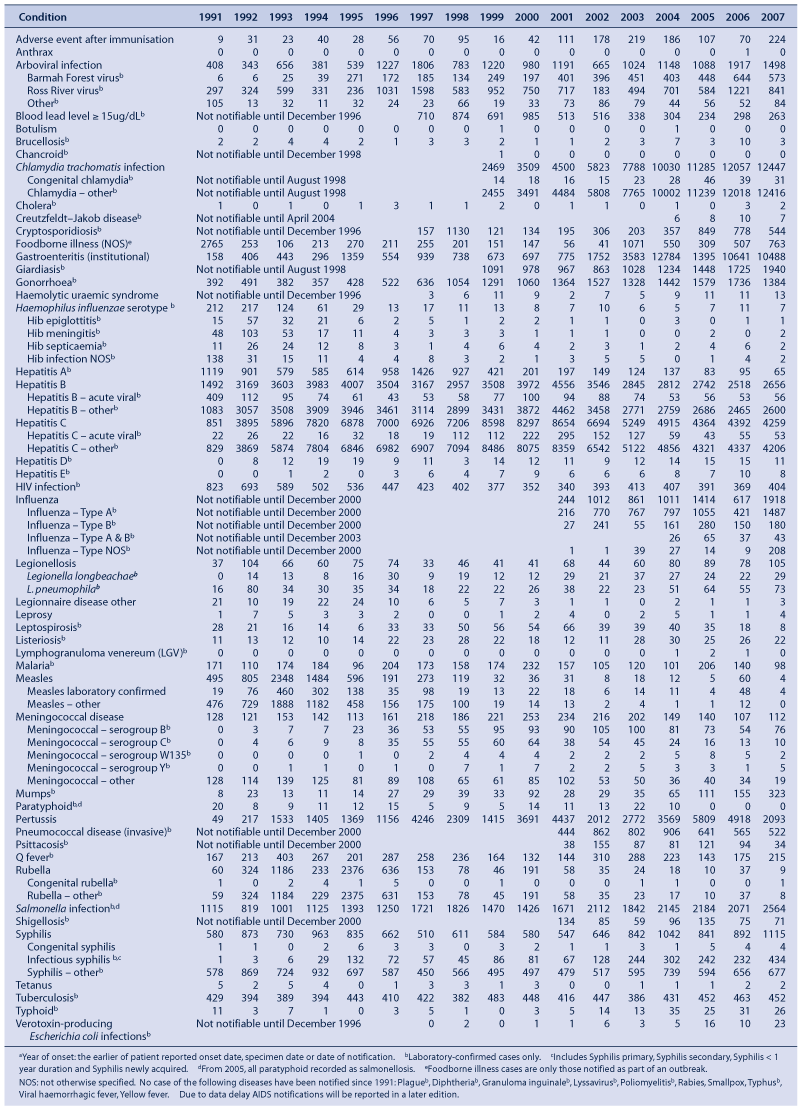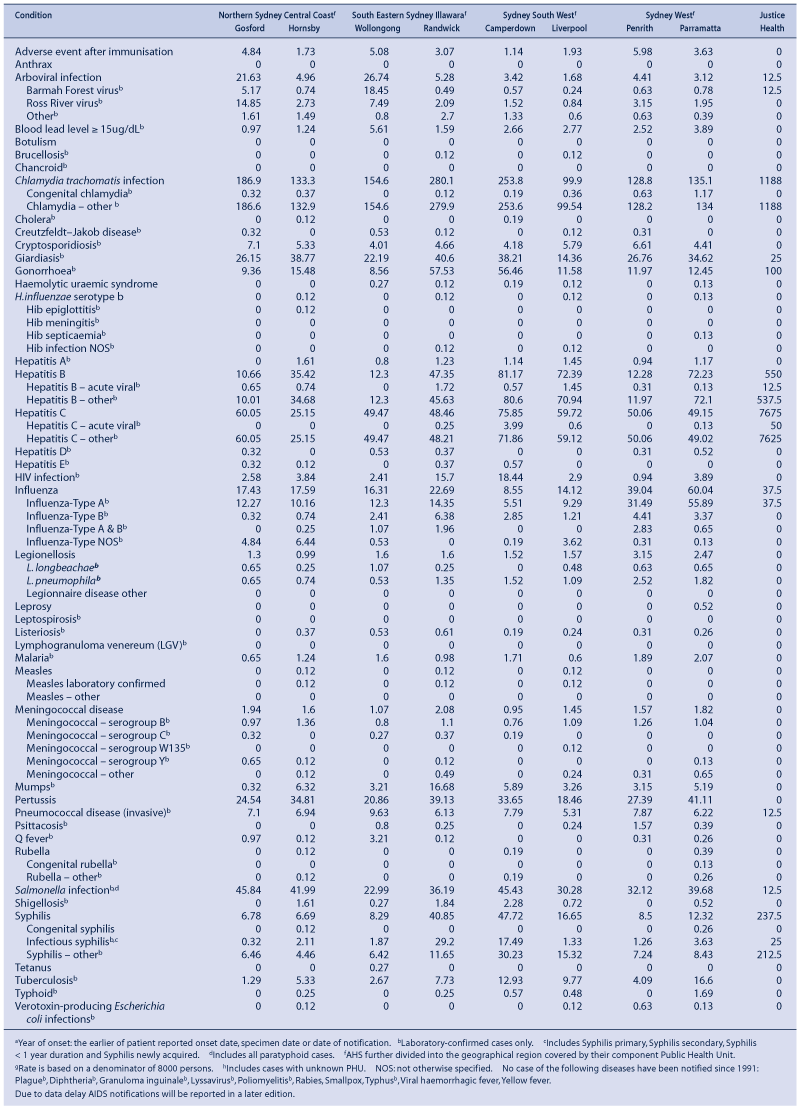Year in review: communicable disease surveillance, NSW, 2007
NSW Department of Health
NSW Public Health Bulletin 19(6) 85-95 https://doi.org/10.1071/NB08013
Published: 26 June 2008
In this issue, we present our annual review of notifiable diseases among New South Wales (NSW) residents. Readers interested in the details of notifications for specific diseases are referred to in Tables 2–6 where diseases are reported by: year of onset; month of onset; Area Health Service (AHS); and age group and sex.

|

|

|

|

|

|

|

|
Trends
Among the 46 706 notifications of medical conditions by doctors, hospital staff and laboratory staff in NSW residents in 2007, highlights included:
Conditions most frequently reported
-
Chlamydia trachomatis infections: 12 447 cases (181 per 100 000 population) with the highest crude rates by geographical area in the South Eastern Sydney Illawarra (Randwick region), Sydney South West (Camperdown region), Hunter New England (Tamworth region) and Greater West (Broken Hill region) AHSs.
-
Hepatitis C: 4259 cases (62 per 100 000 population) with the highest crude rates in the Greater Western (Broken Hill region), North Coast (Lismore region) and Sydney South West (Camperdown region) AHSs.
-
Hepatitis B: 2656 cases (39 per 100 000 population) with the highest crude rates in the Sydney South West (Camperdown and Liverpool regions) and Sydney West (Parramatta region) AHSs.
-
Salmonella infections: 2564 cases (37 per 100 000 population) with the highest crude rates in the North Coast (Lismore region), Northern Sydney Central Coast (Gosford region) and Sydney South West (Camperdown region) AHSs.
-
Pertussis: 2093 cases (30 per 100 000 population) with the highest crude rates in Greater Western (Dubbo region), Sydney West (Parramatta region) and South Eastern Sydney Illawarra (Randwick region) AHSs.
Conditions with the most meaningful declines in the number of notifications compared with previous years
-
Measles: four cases in 2007, the lowest annual count to date and a striking decrease compared with 2348 cases notified in 1993. No local measles transmission occurred in 2007 with all four cases resulting from exposure overseas.
-
Meningococcal serogroup C disease: 10 cases reported for 2007, the lowest number of notifications since laboratory reporting began in 1991, largely due to the introduction of meningococcal C vaccination in late 2003.
-
Gonorrhoea: 1384 cases in 2007 compared with 1736 cases in 2006, a decrease of 20%.
-
Hepatitis A: a record low number of 65 cases, decreased from 1119 in 1991, perhaps in part due to the introduction of a commercially based vaccination in the 1990s. Travel to endemic countries was the most commonly reported risk factor for disease acquisition in 2007.
-
Psittacosis: 34 cases, a 64% decrease compared with 2006.
-
Leptospirosis: eight cases, down from 66 in 2001.
Conditions with the most meaningful increases in the number of notifications compared with previous years
-
Salmonella infections: 2564 cases, the highest annual count to date.1 This increase is mainly due to a large point-source outbreak affecting 319 people who ate Vietnamese-style pork or chicken rolls from a bakery.
-
Infectious syphilis, primarily affecting homosexual men residing in metropolitan Sydney.
-
Mumps: 323 cases, a steady increase from 28 cases in 2001. This increase occurred mainly in the second half of the year in young adults in South East Sydney Illawarra (Randwick region) AHS.
-
Legionnaire disease: 73 reported Legionella pneumophila infections in part due to an outbreak in Sydney central business district in January.
-
Influenza with high rates of disease reported in July and August. There were 25 reported influenza (influenza A) outbreaks in 2007: 21 in aged-care facilities, three in military facilities and one in a boarding school.
-
Verotoxigenic Escherichia coli (VTEC) infections: 23 cases reported, compared with 10 cases reported in 2006. All cases were investigated and no epidemiological links were identified.
-
Giardiasis: 1940 cases reported compared with 1725 reported in 2006.
Conditions least frequently reported
There were no reported cases of anthrax, avian influenza, botulism, chancroid, diphtheria, granuloma inguinale, lyssavirus, plague, polio, rabies, severe acute respiratory syndrome (SARS), smallpox, tularaemia, typhus, viral haemorrhagic fever or yellow fever in NSW in 2007.
Top five notifiable diseases
Rates for the most commonly reported notifiable diseases for each age group and geographical area of residence at the time of notification are presented in Fig. 1 and Table 1. These lists indicate the relative importance of notifiable diseases only and should not be used to indicate the spread of all infectious diseases in NSW. It should also be noted that these rates are heavily influenced by testing practices and, in many instances, do not necessarily indicate the true or relative incidence in the community. Finally, these lists do not include the institutional gastrointestinal outbreaks as comprehensive demographic data are not collected for such outbreaks.
Geographical distribution of notifiable diseases
-
Chlamydia trachomatis infection was the most commonly reported infection across NSW with highest rates observed in regional areas followed by rural and metropolitan areas.
-
Rates of hepatitis C infection were comparable across rural, regional and metropolitan areas. Most of these cases will represent chronic infection rather than acute hepatitis C acquisition and as such may not accurately reflect the recent spread of the hepatitis C epidemic.
-
Arboviral infections are more commonly reported in people residing in rural and regional areas than in metropolitan areas, relating to the distribution of infected mosquitoes.
-
Higher rates of disease are reported for Justice Health compared with the rest of NSW, likely related to higher testing rates for bloodborne viruses and sexually transmitted infections on entry into correctional facilities. Within this population, hepatitis C was the most commonly reported infection, attributable to high rates of injecting drug use.
Age distribution of notifiable diseases
-
Gastrointestinal and respiratory diseases are most commonly reported in children aged under 5 years. This is influenced by the higher testing rates in this age group.
-
Chlamydia trachomatis infections account for the most notifications in adults with rates peaking at 818 per 100 000 in people aged between 16 and 24 years.
-
Influenza is the most commonly reported notifiable disease in adults aged 65 years and older though this rate is markedly lower than that observed in children aged less than five years of age. Children and older adults are more likely to undergo testing for influenza.
Outbreaks and threats
Several notable disease outbreaks and threats were reported in 2007 in NSW. These included:
-
an outbreak of Legionnaire disease in South East Sydney Illawarra AHS related to a contaminated cooling tower in Circular Quay in Sydney (January 2007).2
-
hepatitis C transmission linked to a general medical practice in South East Sydney Illawarra Health Service that specialised in provision of vitamin and mineral injections (March 2007).3
-
a sushi chef who was working while infectious with hepatitis A. Sydney South West Area Health Service provided immunoglobulin to over 400 people who had eaten potentially contaminated sushi. No subsequent hepatitis A cases were reported (March 2007).3
-
a Salmonella infection outbreak associated with eating pork and chicken rolls from a bakery in Sydney South West Area Health Service (March 2007).3
Conclusions
Controlling the spread of sexually transmitted infections, in particular, remains a priority for NSW. This is evident in the re-emergence of infectious syphilis in the gay community and the high rates of Chlamydia trachomatis infections in young adults.
While transmission of some vaccine preventable diseases has been limited in NSW, the challenge still remains to increase vaccination rates among adolescents and young adults to reduce their susceptibility to diseases such as mumps, measles and pertussis.
The increase in Salmonella infections serves as a timely reminder to all to ensure thorough cooking and safe handling of high-risk foods such as raw chicken and other meats, and undercooked, cracked or soiled eggs, while the Legionnaire disease outbreak highlights the importance of cooling tower maintenance.
We thank all those general and specialist medical practices, laboratories, hospitals, schools, child-care centres and others who have notified diseases of public health significance to their local public health units for investigation and control.
[1]
[2] NSW Department of Health Communicable Diseases Report, NSW, for January and February 2007. N S W Public Health Bull 2007; 18(3–4): 66–8.
| PubMed |

[3] NSW Department of Health Communicable Diseases Report, NSW, for March and April 2007. N S W Public Health Bull 2007; 18(5–6): 100–3.
| PubMed |



